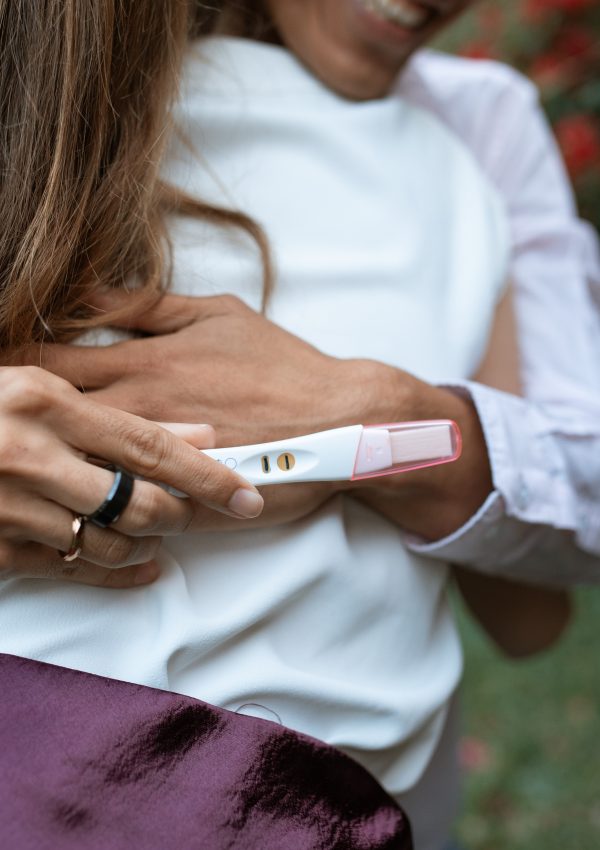Are you beginning your trying to conceive journey but you’re unsure of what you need to do to increase your chances of getting pregnant? Knowing your fertile window is half the battle.
This post may contain affiliate links, which means I’ll receive a commission if you purchase through my links, at no extra cost to you. Please read full disclaimer for more information.

What is a fertile window?
Your fertile window is the period of time during your cycle where you can get pregnant. It’s usually around 6 days, which includes the day that you ovulate and the 5 or so days leading up to it. Ovulation is when one of your eggs is released from a fallopian tube. Once this happens, the egg stays alive for only 12-24 hours. If the egg isn’t fertilized by sperm within that time, the egg dies.
Sperm can actually live in your uterus for up to 5 days, which is why it’s a good idea to time intercourse for the days leading up to ovulation (your fertile window), instead of the day of. Ideally, you want the sperm waiting for the egg to release.
The best way to know when your fertile window is, is by tracking your cycle and using different products that monitor your estrogen and LH levels. Estrogen and LH are both sex hormones that rise during your fertile window.
Many couples make the mistake of having intercourse only on ovulation day and by then, it’s usually too late. Since ovulation day can vary from cycle to cycle, that could be a gamble. Plus it’s hard to tell exactly when ovulation happens.
1. The first thing you need to do is download a cycle tracking app.
Like I briefly mentioned above, using a cycle tracking app is a great way to estimate where your fertile window will land. They work by using the data you enter in order to predict your fertile window, as well as the start of your next period.
The one I use and swear by is Fertility Friend (iOS and Android). It’s free and is the most useful of all the ones that I’ve tried. To use it, you simply click on a day in the calendar and enter information as you please. There is a VIP version you can also buy but the free version tracks more than enough useful information.
If you don’t really like Fertility Friend, some other popular cycle tracking apps are:
They all work similarly so its just a matter of picking whichever one you like best.
2. Next, start charting on the first day of your period.
The next thing you should do is start charting on the first day of your period, which is the first day of your cycle. Charting is basically another word for tracking your cycles and includes the process of actively monitoring your fertile window. The reason you want to wait until the first day of your cycle is because a fertility chart starts on a period.
In order to start charting, click on whichever data tab is in your app. After that, log when you’ve started your period and when it ends.
Optional Cycle Tracking Details
In addition to tracking your period days and the accompanying symptoms, you can also add the following details if you prefer to:
- Basal body temperature (BBT): BBT is your temperature when you are fully at rest. It can be useful to track because it’s a good indicator that ovulation occurred. During the first half of your cycle, your BBT usually trends lower, then the day after ovulation, it should spike. The spike is smaller than you would think so when you track it, you have to record your temperature out two decimal places.
For your BBT to be the most accurate, you have to take it at exactly the same time every morning, before you get out of bed, which can be tedious. You just need a BBT thermometer. If you’re interested in tracking your BBT but don’t want to do it manually, you can purchase a fertility monitor like Tempdrop which logs your BBT multiple times while you’re asleep and takes an average for that day.
- Cervical fluid: This is an important one to consider tracking because your cervical fluid changes frequently throughout your cycle. For instance, right after your period it may be dryer, then it gets sticky, then creamy. Then finally, during your fertile window, it becomes stretchy and slippery like the consistency of an ‘egg-white’. This type of cervical fluid provides the ideal environment for sperm to live and travel to the egg.
- Whether or not you had intercourse: In the trying to conceive community, it’s common practice to have sex every other day during your fertile window, then every day around the time of ovulation. It’s not rigid by any means so if you prefer to do it more or less than that, go for it!
This section also includes our IVF and IUI warriors so if you’re interested in tracking the days you underwent these procedures, you are free to do that as well.
- Ovulation test results: I’ll go into more detail on this below, but recording your ovulation test results is a good idea. Some apps will adjust your predicted fertile window days based on your ovulation test readings.
- Common menstrual symptoms: If you find it helpful to track common symptoms such as backache, bloat, breast tenderness, cramps, etc., feel free. Some apps like Fertility Friend give you specific fields to check off and can more accurately predict your fertile window because of this info.
Once you’ve been charting for a few months, the app will more accurately predict your future cycles. And thus, more accurately predict your fertile window. The app you choose may also highlight your period days and your fertile window, which is incredibly useful.
For example, Fertility Friend will highlight your period days as pink and your fertile window as green. If you look closely, your predicted ovulation days will be a shade of darker green.
3. After that, buy an ovulation predictor kit or fertility monitor
Using an ovulation predictor kit or fertility monitor is the most important step when it comes to tracking your fertile window. They work by detecting your estrogen levels, as well as LH, or the hormone that triggers ovulation.
Ovulation Predictor Kit Recommendations
The one I use and swear by is the Clearblue Advanced Digital Ovulation Test. I like it because it gives you clear results with every reading and it’s very simple to use. In the directions, it will tell you when to start testing based on your cycle length, which is why it’s important to chart.
Clearblue advanced digital ovulation test

You test once a day using your first morning urine, and it will give you one of three readings: low, peak, or high. The high reading means your estrogen levels have increased and is when your fertile window begins. The peak reading is when your LH levels ‘surge’, which means means that ovulation will happen in the next 12-24 hours.
It’s easiest way to test is by urinating in a small Dixie cup and dipping the test strip in. I have never had an error by testing that way. If simply peeing on a stick is easier for you then feel free!
PREGMATE OVULATION TEST STRIPS
If the Clearblue Ovulation Test is not your thing, I’ve also used the Pregmate Ovulation Strips. These are cheaper and good for women who don’t have regular cycles. They’re also great if you want to test multiple times a day.

The main downside is that the results aren’t as clear. You have to compare the darkness of the control line and the test line and that can get tricky. It’s best to start testing with these on whichever day your cycle tracking app says your fertile window begins. These ones also work better if you urinate in a cup and dip the test strip in.
Alternatively, there are fertility monitors that tell you when you’re fertile and some of them connect to apps. These are best for women with irregular cycles. They’re also good for women who aren’t familiar with the process of cycle tracking and are looking for a more advanced product that will do most of the work.
Fertility Monitors
The Mira Fertility Tracking Monitor Kit is one of the fertility monitors that works by connecting to an app. What sets it apart from other brands is that it claims to have laboratory grade accuracy and AI-powered cycle analysis.
The testing process is similar to the Clearblue Ovulation Test in that you dip the testing strips into a cup of urine and plug it into the reader. But the Mira Kit automatically syncs with the Mira app after 16 minutes. From here, you can see very accurate and personalized info about your cycle. Here is the website if you’re interested in researching it!
Mira Fertility Tracking Monitor Kit

4. Lastly, take note of your symptoms
During your fertile window, there are a few symptoms you should definitely take note of:
- Egg-white cervical mucus
- Increased sex drive
- Ovulation pain
- Increase in basal body temperature
- You feel prettier and more confident
If you’re experiencing two or more of these symptoms, there’s a really good chance that you’re fertile.
RELATED POST: 7 Ovulation Symptoms You Can’t Miss
Following this process every cycle will practically ensure that you target your fertile window and increase your chances of getting pregnant. Is there anything you’ve found helpful? Let me know in the comments!
This post was all about how to determine your fertile window.



